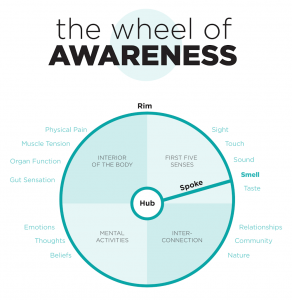
It’s Christmas Eve and many of us are focused on presents rather than presence.
At this time of year once the frenzy is over, the gifts are wrapped and the the chaos abates, we get to slow down and calm down.
Liberated from the maelstrom of over indulgence, spending and preparing, we begin to regain a little control.
The run up to an important presentation often feels like the build up to Christmas; it can be quite stressful.
Daniel Siegel, professor of psychiatry, has a gift for us all at this challenging time of year; it’s the gift of ‘presence’.
Presence is a state of awareness
It is the ability to become fully aware of your experience in the moment. That includes awareness of your current thoughts and emotions.
It sounds simple, doesn’t it?
The challenge is to create a level of awareness that doesn’t focus on thoughts or feelings about the past or the future.
Presence is a beautiful and powerful gift because it allows us to be in the current moment. We get to appreciate everything that surrounds us more fully and allows us to think more clearly and calmly.
Presence is a skill. Developing presence of mind is something we can all learn and it’s worth considering it as a gift to yourself this Christmas.
If the idea of improving your presence of mind appeals to you, there are a number of techniques available to help you to do so.
One of my personal favourites is ‘The wheel of awareness’.
‘The Wheel of Awareness’
Dan Siegel presents ‘The Wheel of Awareness’ as a visual metaphor for the way the mind works. It’s a powerful form of meditation designed to strengthen the mind by helping us to focus our attention and become more aware of our thoughts, feeling and interconnections. I’m mindful of the fact that meditation isn’t a practice that appeals to everyone, although I’d highly recommend you open your mind to exploring this one.
Here is what the wheel looks like (taken from https://www.curablehealth.com/podcast/dr-dan-siegel-wheel-of-awareness)

– The hub is our centre of awareness which represents our ability to pay attention to or focus on anything we choose to.
– Four quadrants represent the ‘knowns’; things that we know about but don’t often stop to think about.
– The rim represents anything we can become aware of.
– Awareness is led by the spoke which represents our ability to focus on any one point on the rim.
As the festivities fade, for many of us our awareness heightens. We reflect on the highs and lows of the year gone by. How we feel, what we’ve achieved, where we are now and where we are heading. Once we switch off our ‘autopilot’ and tune into our ‘hub’, it’s a potent time of year.
I call it a state of ‘Christmas presence’. It’s that sense of connection where many of us take a moment to connect with ourselves, those around us and what really matters. It’s that juncture in time where our spoke of awareness can feel strong and compelling.
Dan Siegel’s ‘Wheel of Awareness’ provides us with a powerful tool for conscious and intentional change. As a public speaking coach it’s a powerful tool for mindful presenting as well.
A gift for presenters and public speakers
Imagine starting the New Year with a whole new level of awareness each time you are called on to present. Whether you are nervous about the idea of standing to speak or are an accomplished presenter, a few moments of deep awareness can bring great clarity.
Your ‘Wheel of awareness’ is the route to achieving the mindfulness you need to speak with confidence and impact. There are four steps:
Acivate your ‘hub’ of awareness
Become aware of mental activities
Feel the sense of connection
Direct your ‘spoke’ of attention to kindness
Step 1. Activate your ‘hub’ of awareness
Breathe
Find somewhere that you can sit quietly and undisturbed for a few minutes.
– Take a few slow, deep breaths; inhaling through your nose and exhaling through your mouth.
– Spend a minute or two simply noticing your breath. Don’t try to change or judge anything; just notice each breath in and each breath out.
Notice
Turn your attention to each of your five senses individually to notice:
– Any sounds you hear both inside and outside of the room you are sitting in.
– What you see. If your eyes are closed notice what that looks like in your mind too.
– How you feel. Your body on the chair, your feet in your shoes, your breath, the temperature of the air, etc.
– What you taste. Your saliva, the remnants of something you ate earlier.
– Any surrounding smells.
As you pay close attention to your 5 senses don’t try to analyse, evaluate or critique anything. Just notice.
Sense
Having taken a few minutes to breathe, relax and notice, now it’s time to feel.
– Slowly scan your body with your mind from the top of your head to the tips of your toes, holding your attention on each part of your body for a few seconds.
– Open yourself up to anything you sense in any part of your body. Simply notice and sensations, don’t try to change, analyse or judge anything. Just notice.
– Slowly scan your body with your mind once again this time paying attention to your inner body.
– Notice any sensations in your inner body; your muscles, bones, organs; any sensations throughout your inner body.
– As you pay close attention to your inner sensations don’t try to analyse, evaluate or critique anything, just notice.
Step 2. Become aware of mental activities
Once you have become more aware of what’s going on with your body it’s easier to check in with your mind. Become aware of:
– Any thoughts that come and go
– How you are feeling
– Memories that pop into your mind
– Your mind wandering into things you have to do in the future.
– As you become more aware of your inner thoughts, feelings, memories and projections don’t try to analyse, evaluate or critique anything, just notice.
Step 3. Feel the sense of connection
– Spend a few moments becoming aware of the people you will soon be presenting to.
– See them in your mind as real people rather than as professionals or your audience.
– Focus on them being someone’s son, daughter, brother, sister, mother or father.
– Spend a few moments reflecting on how much you have in common. Both you and your audience have:
Hopes and fears
Struggled at times
Loved and felt loved
Succeeded and failed
A desire to be the best that you can
The need to connect with others
Step 4. Direct your ‘spoke’ of attention to kindness
You’ve come on a long and important journey in your mind in just a few minutes. Now there is just one thing left to do:
– Take a few more deep breaths and send thoughts of loving kindness. Send them to yourself and send them to your audience.
Take a close look at your ‘Rim’
Is your ‘Spoke’ of attention hovering over:
– Your beliefs about yourself as presenter
– Your thoughts, beliefs of assumptions about your audience
– How you feel, mentally, physically and emotionally about the presentation
‘The Wheel of Awareness’ is an extremely powerful reflective practice. It’s invaluable in helping us to slow down, calm down and connect with ourselves and our audience far more effectively.
At Mindful Presenter we hold the belief that ‘Connecting is Everything’; that connection starts with our very own mind.
Wishing you all a truly wonderful Christmas and a very happy, healthy and mindful New Year!
If you need help developing your presence in public speaking:
– Book yourself onto a powerful public speaking course.
– Invest in some really good one to one public speaking coaching.
– Get yourself some excellent presentation training
I really hope you enjoyed this post. If you did, please feel free to share it through your preferred social media channels below and subscribe to our mailing list so you won’t miss any future posts.
If this article has inspired you to learn a little more about how effective your presentation skills are you may want to take a look at our presentation training and public speaking coaching pages to see how we may be able to help you. You will also find a great deal of really helpful ‘free’ information in our Learning Centre.

Leave a comment